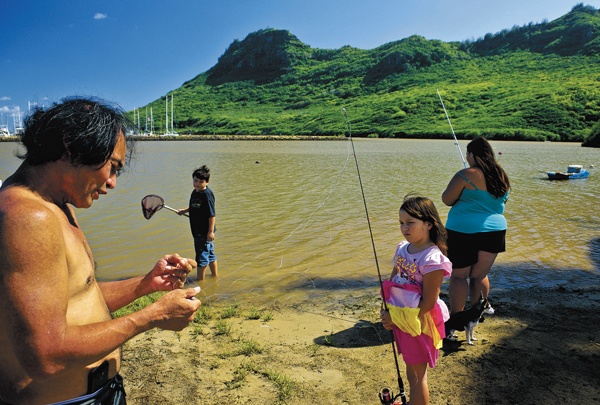LIHUE — High wind and surf. Heavy rain. Flash flood warnings. And, of course, lots of brown water along the coast. That has been the situation on Kauai over the past few days — not surprising for November on the
LIHUE — High wind and surf. Heavy rain. Flash flood warnings. And, of course, lots of brown water along the coast.
That has been the situation on Kauai over the past few days — not surprising for November on the Garden Isle.
But with heavy rain and murky water come bacteria and a host of other potential hazards.
On Sunday, the state Department of Health issued a Brown Water Advisory for all north- and east-facing shores, from Nawiliwili to the Na Pali coast, urging people to stay out of the water for health reasons.
“The public is advised to stay out of flood waters and storm water runoff due to possible overflowing cesspools, sewer manholes, pesticides, animal fecal matter, dead animals, pathogens, chemicals and associated flood debris,” the advisory states, which remained in effect Monday.
On Saturday, a day before the advisory was issued, Kauai Surfrider’s Blue Water Task Force collected water samples from around the island, part of its monthly effort to test for Enterococcus — bacteria that indicates contamination from feces of warm blooded animals, including humans.
The test results were anything but pleasant.
Dr. Carl Berg, project manager for BWTF, said Saturday provided a unique opportunity for Surfrider to show exactly why such advisories are important.
“We have very few cases where we actually get samples while it is raining, (and) streams are flooding,” Berg said. “And the bacteria counts are astronomical.”
Of the 20 areas sampled, 13 exceeded the DOH’s single sample pollution standard.
In a 100-milliliter sample, there should be less than 104 counted bacteria. If the count exceeds 104, the water is considered polluted. The geometric average of five collected samples should not exceed more than 35 bacteria per 100 ml.
“The streams were really filthy and Hanalei River had a count of 3,873 (bacteria), 37 times the limit,” states the BWTF’s Nov. 9 report.
However, Hanalei paled in comparison to Huleia River at the Niumalu County Beach Park, where 9,804 bacteria were counted in a 100 ml sample — 94 times the single sample limit.
Other highly polluted areas Saturday included Nawiliwili Stream (74 times the limit), Hanamaulu Stream (30 times) and Koloa Landing (17 times).
Berg described some of the concentrations as “outrageously high,” but said he has seen counts in the past exceeding 26,000 bacteria per 100 ml.
“The higher the count, the higher the public health risk,” he said.
County spokeswoman Beth Tokioka said Monday she received confirmation from Kalani Vierra, head of the Kauai Fire Department’s Ocean Safety Bureau, that lifeguards “do not generally close beaches” during brown water advisories.
However, they do advise oceangoers not to swim, snorkel or surf, and to seek other clean water beaches.
“This all depends on the clarity, debris and other hazards due to flooding,” Tokioka wrote.
Mel Wills, operations manager at Holoholo Charters, said brown water advisories certainly affect business, but that his company’s parameters for letting passengers in the water to snorkel surpass such warnings.
“The danger of shark attacks in murky waters is enough to keep my passengers out of the water,” he said. “Sometimes we go weeks without snorkeling.”
Monday was the third straight day Holoholo was forced to keep its boats at the docks altogether, in light of the recent thunderstorms, high surf and wind.
Alicia Millare, who books reservations at Captain Andy’s Sailing, said the advisories also impact the company’s operations, as they do not allow customers to snorkel in murky water.
Due to weather conditions over the weekend, the company has not run a tour to Na Pali since Saturday, when one of its boats was forced to turn around in choppy water and provide refunds to passengers, according to Millare.
“We’re rerouting to the South Shore this evening,” she said Monday.
While Brown Water Advisories are important, Berg does not feel they are doing enough. He said DOH should post signs — similar to those posted by lifeguards during high surf — to warn people of the dangers associated with murky water.
Berg said he cringed Monday when saw several surfers out in the water near Wailua.
“As long as the water is brown you are advised to stay out,” he said, adding he expects the advisory to last through at least today.
One Kauai resident, who didn’t want to give his name, said he was “shocked” to see surf companies giving lessons Sunday in front of the Hanalei River mouth.
Surfrider’s BWTF reminds those who have to get in murky water to rinse off as soon as possible.
On Sunday, the DOH also issued a Brown Water Advisory for the entire island of Oahu.
A high surf advisory for north and east-facing shores of Kauai, Niihau, Oahu, Molokai, Maui and the Big Island was expected to remain in effect until 6 p.m. Monday, according to The National Weather Service.
However, the break will likely be short-lived.
“A storm low to the north will send another large north swell across the area on Tuesday night and Wednesday, with warning level surf possible,” according to NWS’ marine forecast Monday.
To view the Blue Water Task Force’s most recent report, visit http://kauai.surfrider.org/what-we-do/blue-water-task-force.
• Chris D’Angelo, environmental reporter, can be reached at 245-0441 or cdangelo@thegardenisland.com.



